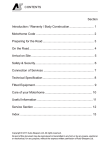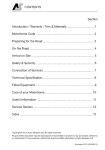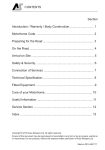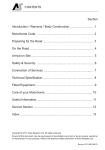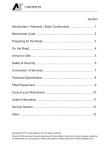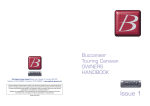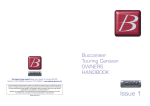Download Thoughts on Motor movers
Transcript
The UK trade body for the caravan, motorhome, caravan holiday and park home industry. Code of Practice 305 Caravan Movers Issue 1.1 (minor revision) Publication Date: July 2011 COP_305_1.1 July 2011 Caravan Movers COP 305 Issue 1.1 1 Scope This code of practice specifies the safety and technical requirements for the design and fitment of caravan movers that are used to move touring caravans by applying force to the main caravan wheels. This code of practice also defines clearance and interface requirements for a caravan Manufacturer to enable the fitment of caravan movers as an aftermarket product. It also specifies information for the user that a retailer must provide when supplying and fitting a caravan mover. 2 References 2.1 Regulations - Machinery Directive 2006/42/EC - EMC Directive 2004/108/EC - Radio interference in Vehicles 2004/104/EC (last amended 2006/28/EC) - R&TTE Radio equipment Directive 1999/05/EC - Low Voltage Directive 2006/95/EC - Masses and dimensions of motor vehicles class M1 1992/21/EC - Masses and dimensions of certain categories and trailers 1997/27/EC 2.2 Normative standards EN 1648-1:2004 Leisure accommodation vehicles – 12Vdc extra low voltage electrical installations. Part 1: Caravans 2.3 Informative standards EN 1645-2:1999 Leisure accommodation vehicles – part 2: User Payload 3 Definitions 3.1 Caravan mover A permanently fitted device for slowly manoeuvring a touring caravan, powered by an electric machine. 3.2 Drive roller Used to transmit the drive from the caravan mover to the tread of the caravan tyre, it engages onto the tyre with a preset force. 3.3 Engagement The drive roller is positively engaged onto the tyre either automatically or manually from a neutral position. Automatic engagement is done by the unit in response to a user control. Manual engagement is done by mechanical means. 3.4 Mass of a caravan mover The mass of a caravan mover MA is the sum of all the parts needed for the correct function of the whole system except the original caravan battery, includes any parts added at the installation: cables, mounting parts, control, etc, as specified by the mover manufacturer. COP_305_1.1 July 2011 2 of 7 Caravan Movers COP 305 Issue 1.1 4 Requirements 4.1 Safety a) When engaged to a caravan tyre the mover shall be able to hold the caravan mass on a 1:5.5 (18%) slope up to the maximum specified mass, Mmax, by the caravan mover manufacturer. b) The user control shall be fitted with a failsafe that stops the unit when positive pressure is removed from the control or when power is lost due to electrical disconnection, i.e. operates like a dead man’s handle. c) When a remote controller is used, e.g. a hand held device using an RF link, the unit shall come to a stop when out of range of the remote controller. d) A means shall be provided to prevent engagement of the mover when the caravan is being towed. e) The maximum speed, Vmax, achievable by a caravan powered by a mover, shall not exceed 25m/min (see test defined in 4.4 b). 4.2 Electrical a) Any new electrical installation to power or control a caravan mover shall not employ any part of, or interfere with, any existing circuits that are not designed for this use. b) The caravan mover wiring shall: - connect directly to the leisure battery or additional specific battery if required by the system, - the cable from the positive pole of the battery must have additional mechanical protection to the point of the protective device (fuse), - where this cable passes through the battery compartment wall it shall not allow gases to pass into the habitation area of the caravan, - the cable shall not pass through the battery compartment floor or permit leakage from the battery compartment, - a protective device to protect the supply cable shall be placed as close as possible to the battery positive pole, outside the battery enclosure but in no case more than 1000mm away, - an isolator switch to disconnect the positive supply shall be provided, c) Cables sizes shall be selected with consideration of the maximum current and overload conditions of the caravan mover. d) The caravan mover shall be tested according to European directive 2004/108/EC and 2004/104/EC for EM compatibility and shall bear the e-type-approval number (on the type plate) given by the type approval authority. e) The caravan mover shall comply with European Directive 1999/5/EC for band selection and exclusivity. To show evidence the manufacturer shall deliver a Declaration of Conformity which states the band frequency used. f) Caravan movers shall provide protection to IP55 according to EN 60529 for all external electrical connections. COP_305_1.1 July 2011 3 of 7 Caravan Movers COP 305 Issue 1.1 4.3 Mechanical a) The drive roller used by the caravan mover shall: - withstand the engagement force and transmit the drive torque onto the tyre without causing damage to the tyre, - have minimum dimensions of 100mm in length and 48mm in diameter, - contact the centre of the tyre. b) The caravan mover shall have a facility for manual disengagement of the drive in the event of loss of battery power. The caravan mover shall not automatically disengage on such an occasion. c) When assembled to a caravan, the assembled unit shall achieve the following clearances with the caravan loaded to MTPLM: - not protrude outside of tyre, - the clearance to the tyre of non driven parts not be less than 10mm, - the roller clearance to tyre when the roller is disengaged shall be not less than 10mm, based on the maximum tread depth of the tyre and in any position achieved by the caravan wheel suspension travel. d) When fitting a caravan mover, consideration shall be given to maintaining ground clearance under the caravan; taking into account the need to traverse speed humps in the road. 4.4 Performance For compliance to this CoP, the mover manufacturer shall demonstrate the following requirements. The user shall be alerted with an audible and visual warning when the caravan mover is running low on power. The following tests apply. The caravan mover shall be fitted on a caravan or test chassis for type approval using the maximum weight that the mover is intended to fit. Ensure that all the tyres of the test vehicle are pressurised correctly, according to the manufacturer instructions. a) Uphill test: The test shall be carried out under dry conditions on solid ground up a 1:6.7 (15%) gradient. The caravan shall be moved upwards for at least 5m without interruption. b) Downhill test: The test shall be carried out under wet conditions on solid ground down a 1:6.7 (15%) gradient. The caravan is moved downwards for at least 5m and then stopped by the caravan mover. It shall stop completely within 0.5m. The maximum velocity Vmax is measured: it shall not exceed 25m/min. COP_305_1.1 July 2011 4 of 7 Caravan Movers COP 305 Issue 1.1 4.5 Installation a) Caravan movers installed shall be suitable for the mass of the caravan, in order to achieve the performance criteria of this CoP. b) The caravan mover manufacturer’s installation instructions shall be in accordance with this Code of Practice. c) Caravan movers shall only be installed in accordance with the mover manufacturer’s installation instructions. The caravan manufacturer shall state this requirement in the caravan handbook. d) Fitting of a caravan mover shall not damage or impair the performance of the caravan, the caravan chassis or tyres. e) Caravan movers shall only be fitted by Technicians trained by the caravan mover manufacturer or workshops approved by the NCC under the Approved Workshop Scheme. f) Prior to installation, consideration should be given to the battery capacity and the manufacturers maximum discharge rate to ensure use of the caravan mover will not damage the battery. g) To install the caravan mover no original equipment shall be removed from the caravan. h) Upon completion, the Technician, Workshop or Dealer will formally hand over the fitted unit to the owner and complete the handover checklist in APPENDIX A. The handover shall include: - an explanation of the increase in the mass of the caravan, - clarification that the increase in mass will come out of the user payload unless a weight upgrade is made for the mover, - demonstrate safe operation of the caravan mover and use of the controller, - emphasis of the importance of correct tyre pressures and advise of any re-rating required, - fitment of any manufacturer prescribed labelling, - issue any manufacturer documentation, - complete the declaration of compliance, found in APPENDIX A. COP_305_1.1 July 2011 5 of 7 Caravan Movers COP 305 Issue 1.1 4.6 User Manual The manufacturer shall deliver a manual in order to instruct the end user on the safe and proper use of the caravan mover. The manual shall contain the following information: a) Instructions for the safe use of the caravan mover, b) Product name, producer name, address, c) Detail how to use the mover and the caravan handbrake: - at start, engage mover then release handbrake, - when finished, pull handbrake on then disengage the mover, - the mover should be left disengaged, d) That the user payload will be reduced by adding a mover to the caravan unless the caravan is given a weight upgrade – the reduction shall also be stated, e) Effects of using the caravan mover on the leisure battery performance and current draw of the mover in operation, f) Safety warnings: - use the correct tyre pressure at all times – found in the caravan handbook, - do not let children play with this product, - keep clear of caravan when manoeuvring, - disconnect from mains hook-up before use, g) Weight MA of caravan mover [kg], h) Maximum weight Mmax [kg] of caravan that the mover is designed for, i) Declaration of Conformity, j) Warranty conditions, k) Maintenance requirements clearly stated as per the manufacturers recommendations, 4.7 Caravan mover warranty - minimum 2 years parts and labour, - this shall be stated in the user manual. COP_305_1.1 July 2011 6 of 7 The UK trade body for the touring caravan, motorhome, caravan holiday and park home industry. APPENDIX A Caravan mover handover checklist This checklist is to be completed by the installing engineer or dealer representative responsible for the handover of the touring caravan fitted with a mover in the presence of the owner. Caravan mover complies with technical and safety requirements of NCC CoP 305 Caravan mover installed in compliance with CoP 305 Explanation of the impact of added weight to user payload Demonstration of safe operation of the fitted mover and controller Declaration of compliance By signing below, both parties confirm that the matter has been discussed and understood. Make and model of mover: Ser. No. This caravan mover complies with NCC Code of Practice 305 Full customer name and address Fitted by (dealer stamp) Caravan make and model Caravan CRiS number Engineer’s name Owner’s signature Engineer’s signature Date Date COP_305_1.1 July 2011 7 of 7







